Shih Tzu Separation Anxiety
Leaving Your Shih Tzu Home Alone
Overview
Separation anxiety in dogs is a psychological condition characterized by extreme distress and behavior problems when separated from their owner or left alone. It is more than the typical whining or mischief that dogs might display in their human's absence; it is a serious condition that can lead to destructive behavior, excessive barking, depression and even self-harm. This anxiety is rooted in a dog's instinctual need for social connection and fear of being isolated or abandoned.
This article will cover everything you need to know about Shih Tzu separation anxiety, including exact steps to address it from multiple angles. If your Shih Tzu is suffering from this issue, know that there are effective ways to manage it and reduce its impact. The goal is a happier, more confident Shih Tzu that is properly equipped to handle some time alone.

Please note: AllShihTzu is reader-supported, and some of the product suggestions on this page are affiliate links. As an Amazon Associate we earn from qualifying purchases. This is at no extra cost to you and helps keep this site running.
Signs of Separation Anxiety:
A Shih Tzu may show one, some or all of the following signs:
- Sensitivity to cues that you're planning to leave and responding with clinginess, anxiety or pacing
- While you are gone there may be excessive vocalization including barking or continual despondent whining
- Urinating or defecating due to stress
- Self-licking due to stress
- Panicked behavior or restlessness that may manifest as destructive chewing, ripping things apart, trying to escape, or even ramming into walls.
- Unable to quickly recover upon your return due to emotional exhaustion, may show signs of depression
- Upon your return, excessively clingy behavior
Note that since owners are not home to see all that is happening while away, often it is a dog’s behavior when they return home or signs of disturbance that lets them know there are separation anxiety problems.
Rate of Occurrence & Age of Onset:
Rate of Occurrence: Looking at all breeds in general, it's estimated 20 to 40% of puppies and dogs have some level of separation anxiety. In regard to just the Shih Tzu breed, a poll conducted by us at AllShihTzu showed separation anxiety as the second most challenging behavior reported by pet parents of Shih Tzu dogs (only topped by housebreaking and seen more often than refusing to listen or eating issues).
Age of Onset: Issues with separation anxiety can occur at any age. Puppies can get stressed without reassurance and comfort. Adults that have close bonds with their humans can feel incredible levels of loneliness when on their own. And seniors, especially those that have some cognitive issues, often become more clingy and do not like to be home alone.
Exact Steps to Address Separation Anxiety with Shih Tzu Puppies and Dogs:
There are many things you can do to help a Shih Tzu with separation anxiety. Do please note that choosing just one of these methods will do very little. It is often when several, or all, are implemented together that the combination will address both a Shih Tzu's emotional needs and physical needs and serve as stepping stones to developing a more confident, independent dog.
#1: Create a secure designated area to serve as a 'den'.
Certain behaviors in dogs are instinctual, and their positive reaction to a 'den' is a prime example. Here's why this can be beneficial:
- Provides a Feeling of Security: A den naturally evokes safety and security for dogs. This instinct is evident when dogs seek enclosed spaces during storms, a behavior also observed in wolves who use ancient dens.
- Reduces Feelings of Isolation: In contrast, a dog in a large, empty area may feel more isolated. The absence of a den-like space can amplify feelings of loneliness.
- Keeps Essentials Within Reach: Without a designated space, important items like toys and comfort items (more ahead) may be too scattered, making them less accessible during stressful times.
Creating a den-like space can be simple. Set up an indoor playpen like the North States Indoor Playpen in a family-used area. This will be equipped with a comfortable bed, engaging toys, food and water, a companion toy, an item with your scent, and pee pads (more details ahead).
#2: Provide methods for your Shih Tzu to stay busy
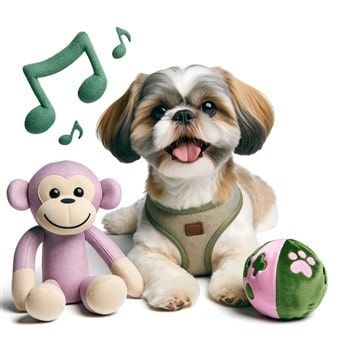
Leaving your Shih Tzu alone with nothing to engage with is the last thing you want to do. To keep your little guy or gal entertained offer the following:
- Interactive Toys: Offer a variety of toys that respond with sounds when touched, such as toys that talk, squeak, or rustle. A beloved one is Spencer the Crinkle Monkey that just as entertaining as he is cute.
- Chew Toys: Provide chew toys with appealing textures and/or scents to provide lots of jaw work. One that's become a favorite is the Dogwood Wood Alternative Chew Toy; it has all the taste and texture of a natural tree branch, but is safe. It can withstand strong chewers and starts at size extra-small, so there's options for puppies and dogs of all ages.
- Treat-Dispensing Toys: Use a toy that releases treats, filled with a mix of your dog's regular dry kibble and a bit of 100% natural smooth peanut butter. A cute and fun option is the Petstages Carrot Stuffer Treat-Dispensing Toy.
#3: Provide a companion toy.
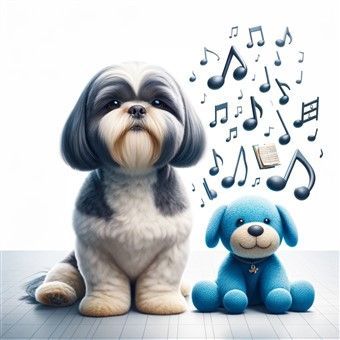
A companion toy can be be extremely helpful when a Shih Tzu is suffering from separation anxiety. This type of toy is designed to mimic a living creature, to serve as a friend. This is achieved via accurate sizing, and two elements that make a toy ‘alive’: a heartbeat (battery powered) and body warmth (via warming pads). It can work wonderfully to help ease loneliness and feelings of isolation.
The one that we highly recommend is the SmartPetLove Snuggle Puppy. There are some copycats, but this is the original that is durable, washable and a dependable high quality toy.
#4: Make environmental changes.
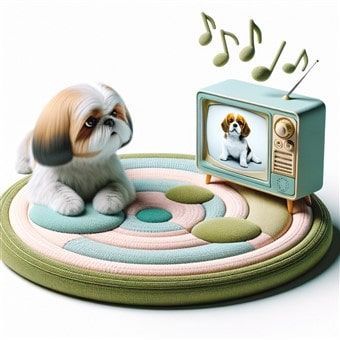
Creating a welcoming and secure atmosphere involves a few key steps:
- Ensure lighting is adequate: It's wise to leave lights on, as unexpected stormy weather or the onset of dusk can make your home feel darker and more isolating than anticipated.
- Monitor sun glare in your dog's resting area: On days you're at home, observe how sunlight enters the space where your Shih Tzu spends most of their time. It can be hard to relax with intense sunlight streaming in. Consider relocating their play area or modifying the curtain setup if necessary.
- Evaluate the placement of your Shih Tzu's playpen in relation to air conditioning or heating vents, as this can affect their comfort.
- Avoid complete silence in the house: Explore music options designed for dogs, which are available on CDs or through digital streaming. These tunes can range from soothing melodies to more engaging sounds, like animal noises. A popular one is Through a Dog's Ear by Joshua Leeds and Lisa Spector. Additionally, some TV service providers offer pet-specific channels, which can be found in sections like 'On Demand'. These channels provide visual and auditory stimulation for pets.
#5: Break up the day.
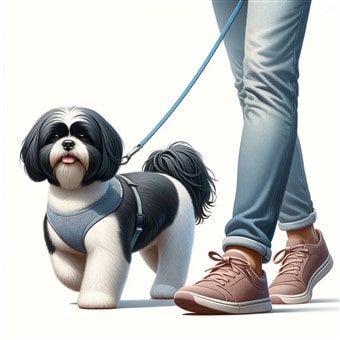
To reduce the stress of extended alone time for a Shih Tzu, short breaks can be very helpful. While not all pet parents may find these options feasible, they are provided here for consideration in case you can implement any of them.
- Lunchtime Visits: Visit your dog at home during lunch for a quick play session and a bathroom break, even if it's only for 10 minutes.
- Dog Walker Arrangements: Opt for a dog walker, either a professional or someone familiar like a friend, family member, or neighbor. Ensure your Shih Tzu is acquainted with them beforehand and give them detailed care instructions.
- Interactive Pet Cams: Consider using an interactive pet cam. Although it might be an investment, and it is certainly not for every budget, it enables you to watch, talk to, and give treats to your Shih Tzu remotely through an app. Some cams also include two-way audio. One that we like is the Pet Camera with Treat Dispenser by Lusimpo, a local California company
#6: Reverse the cues regarding your departure.

Your Shih Tzu may recognize cues like handling keys or putting on shoes as signs you're leaving, which can cause them to start worrying much earlier than they need to and cause unnecessary stress. To counter this, mix these actions into your daily routine without actually leaving:
- Randomize Departure Actions: When you're at home, sporadically perform activities like picking up keys or putting on shoes, without it leading to leaving.
- Varying Playpen Time: Place your Shih Tzu in their playpen and leave the room for periods ranging from 5 to 15 minutes, then return casually and release them.
- Front Door Routine Variation: Open the front door occasionally as if to check the weather, then resume indoor activities. Sometimes, step outside for a brief duration of 5 to 15 minutes before coming back in.
This approach can train your little guy or gal to understand that these usual departure signals do not necessarily indicate a long period of separation.
#7: Follow exit guidelines.

Please ensure to follow these steps in sequence:
- Early Morning Routine: Wake up with enough time to spare, avoiding a hurried atmosphere. A rushed environment can lead to your dog feeling anxious. Allocate ample time to complete the following steps.
- Bathroom Break: Take your dog outside to attend to their bathroom needs, dedicating at least 15 minutes for this activity.
- Morning Walk: Embark on a morning walk, aiming for a minimum duration of 20 minutes.
- Pre-Departure Setup: Place your dog in their playpen well before your departure.
- Quiet Goodbye: Refrain from overly affectionate farewells like hugs and kisses; such actions are strong signals of leaving. Though it may feel counterintuitive, it's best to depart quietly.
- Managing Your Concerns:
Avoid spending the day in worry. If your dog is in a safe environment (as per tip #1), has access to separation anxiety aids (covered in tips #2 and #3), and is in a pleasant and secure setting (as mentioned in tip #4), you should notice improvements. If you've arranged activities to break up their day (as suggested in tip #5), this is even more beneficial.
#8: Keep your arrival back home calm and casual.
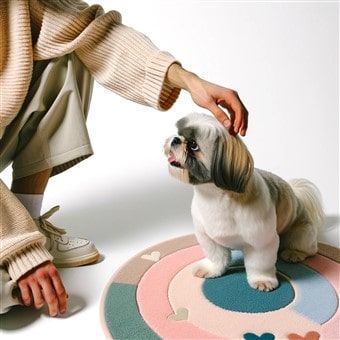
When you return home after a long day, it's natural to want to shower your Shih Tzu with affection through hugs, kisses, and plenty of attention. However, for dogs with separation anxiety, making a big fuss upon arriving home may actually be counterproductive. Overly enthusiastic greetings can unintentionally convey a message interpreted by dogs to be 'I can't believe I made it back! This is a miracle!', reinforcing the dog's anxiety.
Instead, it's more effective to enter your home in a relaxed manner. Take a moment to get a drink of water in the kitchen, browse through your mail, and then, after a brief pause of 1 to 3 minutes, calmly greet your Shih Tzu in a straightforward way with a simple, pleasant "hello" and some gentle pets. Following this, take your little guy or gal outside to attend to their bathroom needs. Afterward, there will be ample opportunity for giving all the excited attention and love they deserve.
Supplements and Medications Overview:
This sort of treatment is typically reserved for dogs that have severe and persistent cases of separation anxiety that do not respond to all of the above remedies. There are both OTC and prescribed medication options.
OTC Supplements:
Various over-the-counter supplements like L-tryptophan, chamomile, passion flower and melatonin can aid in calming dogs. L-tryptophan, an amino acid, helps regulate mood without causing drowsiness, which is ideal for many dogs. Melatonin is sometimes used as a stress reduction in dogs, but it's normally a sleep aid so it can cause quite a bit of drowsiness. Both chamomile and passion flower can help, but normally work best in conjunction with other calming aids.
Keeping this in mind, you may want to consider Good Trouble Pets Calming Supplement for Dogs, which has L-tryptophan as well as chamomile, passion flower, and ginger root (calms the tummy).
Prescribed Medications:
Generally used as a last resort due to potential side effects, the most common types are:
- Benzodiazepines: These can lead to side effects like sleepiness, increased appetite, and possibly heightened anxiety. They may also impact memory and learning abilities.
- Antidepressants: These include drugs like buspirone and clomipramine (a tricyclic antidepressant). Common side effects are loss of appetite, restlessness, nausea, and in some cases, aggression or hyperexcitability. Clomipramine might also cause lethargy, vomiting, diarrhea, liver enzyme elevation, confusion, increased thirst and heart rate, or convulsions. Additionally, MAOI antidepressants can be harmful if a dog has consumed cheese products recently.
In summary, while these medications can be effective for severe cases, their use requires careful consideration due to the range of possible adverse effects.
A Final Note:
It's never fun leaving our little guys and gals home alone, but if you take the time to address and resolve separation anxiety, this will greatly improve your Shih Tzu's emotional well-being and make it easier on your stress level as well.
More Articles for You:
Shih Tzu Itchiness Issues - Being itchy is a very common issue seen with the Shih Tzu breed. There can be an itch with no other symptoms or lots of other problems like rash, hot spots, or dry skin. See exactly how to remedy this.
Lovely Leave-in Sprays for a Fresh Coat - Have your Shih Tzu smelling amazing while keeping their coat soft, shiny and well cared for. These five light, lingering scents add just the right finishing touch.
Shih Tzu Dental Care - Oral health is at the top of concern for the Shih Tzu breed and all pet parents should be actively cleaning their Shih Tzu's teeth. See our top tips to keep your little guy or gal's teeth clean, to prevent infections and future tooth loss.
The Best Interactive Toys for a Shih Tzu - If you're looking for some great toys to help teach independent play or some ways for your sweetie to stay occupied when your focus is elsewhere, you'll love these finds.


